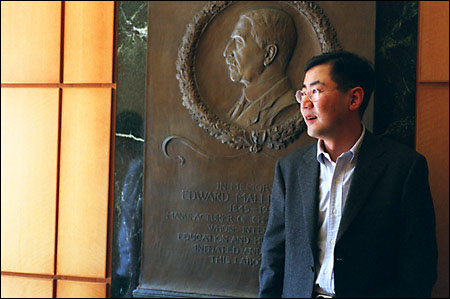It’s a small, small world for Hongkun Park
Professor’s humor keeps students awake

Hongkun Park thinks small to get big results.
The 37-year-old professor of chemistry and of physics recently made an electronic switch the size of a molecule, too tiny to see directly or even to visualize in your mind. One of his goals is to determine how minute you can make an electronic device and still have it do useful work. He talks about sizes measured in atoms and gadgets millionths of an inch in size.
Devices like that could revolutionize computing, communications, cryptography, and medical instruments – things that could make an inventor a billionaire. But Park, a good-natured fellow with a ready smile, is not much interested in that kind of payoff. Rather, he is trying to couple his molecule-size switches to functioning brain cells to see how a memory or thought is made, or a sensation felt. In other words, he wants to get down to the basics.
“Hongkun is a remarkably deep scientist who pushes the fundamental understanding of molecular and nanoscale devices to the highest (or lowest) levels of any scientist worldwide,” says Charles Lieber, Hyman Professor of Chemistry. That’s great praise from a man who has made it big in the small world himself. Lieber and his students recently fashioned a device that can detect a single virus out of wires so small you can put 100,000 of them on a pinhead.
A love affair
Park also receives accolades for his teaching prowess. James Anderson, Weld Professor of Atmospheric Chemistry, characterizes him as “a rare combination of superb science, inspired teaching, and a sparkling sense of humor.”
Lieber adds that, “Hongkun has elevated introductory chemistry to new heights both in terms of content and enjoyment. His ability and humor makes this 9 a.m. class one that freshmen don’t object to getting up ‘so early’ to attend.”
Park grew up in South Korea in a family “with enough doctors to staff a small hospital. But I was always more interested in science,” he adds.
Park vividly remembers one door to science that he walked through at an early age. “I was only 5 or 6 years old when an uncle, who is now a professor at Purdue University, gave me some science magazines written for middle school and high school students. I enjoyed them very much even though I didn’t understand a lot of the contents.”
That interest led him to study chemistry at Seoul National University. He met his wife, Jina, in a chemistry class there. “She was an excellent student,” he recalls. “I talk to her about my work now, and she comments on it. That’s something that’s fun for both of us.”
After Park graduated in 1990, he was issued a gun and helmet in addition to a diploma. He served 18 months as a private in the Korean army, a requirement for all healthy young men in that country. “I hated the military while I was in it,” he comments. “But looking back, it wasn’t so bad. I met a lot of people whom I never would have met, and I learned a lot from them.”
After his discharge, Park married Jina and they came to Stanford University together. She could not obtain a visa to work in the United States, so boredom sent her back to Korea where she took a job as a high school science teacher. They were separated for three and half years.
Park chose Stanford because of Richard Zare ’61, Ph.D. ’64. “I read a lot of his papers when I was a college senior and liked what I read,” Park recalls. It was a good choice. “Zare taught me so much about how to do and appreciate science,” he says. “Working with him, I discovered why I was so excited about science.”
As a postdoctoral fellow at the University of California, Berkeley, Park started working in nanoscience, an enterprise where everything is measured in billionths of meters or millionths of inches. The field was beginning to burgeon with scientific and commercial potentials, and he had to decide between a career in finance or academia at the point. Love of science for science’s sake won out.
Affairs with science
That love brought him to Harvard in 1999. “That was a crazy year for me,” he recalls. “I had a new job, a new daughter, a new house, and my first course in chemistry to teach. I hardly slept at all.”
Park received tenure in 2004. He had already made his mark in the nanoworld when he wired an individual molecule so that it serves as an electronic switch, a transistor that turns the flow of electricity on or off. Harvard Magazine noted that this device is so small that it wiggles when a single electron, one of the lightest particles in the universe, passes through it.
Now Park is trying to modify such molecules so they can emit or detect a single photon, or unit of light, a thing even more ethereal than an electron. There’s no doubt that circuits of light will handle more information more quickly in the future than electric circuits do today.
Park also researches the peculiar properties of nanowires made from certain metal oxides that change their physical characteristics as they become smaller. Such wires may hasten the day when nanoscale devices will be found in every room in your home.
Park is also trying to connect his molecular detectors and switches to functioning networks of brain cells. He aims to track exactly what kind of chemistry and physics occurs when a memory is made, a face is recognized, an emotion is felt. That’s an unnerving goal that Park is not sure he can attain. “I don’t know if I can do it,” he admits, “but it will be a lot of fun to try.”




